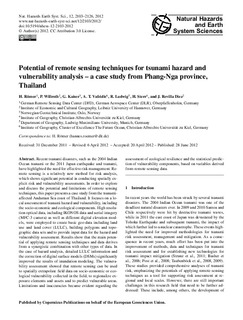Potential of remote sensing techniques for tsunami hazard and vulnerability analysis – a case study from Phang-Nga province, Thailand
Journal article
Permanent lenke
http://hdl.handle.net/11250/2375297Utgivelsesdato
2012Metadata
Vis full innførselSamlinger
- NGI articles [1061]
Originalversjon
Natural hazards and earth system sciences 2012, 12(6):2103-2126 10.5194/nhess-12-2103-2012Sammendrag
Recent tsunami disasters, such as the 2004 Indian Ocean tsunami or the 2011 Japan earthquake and tsunami, have highlighted the need for effective risk management. Remote sensing is a relatively new method for risk analysis, which shows significant potential in conducting spatially explicit risk and vulnerability assessments. In order to explore and discuss the potential and limitations of remote sensing techniques, this paper presents a case study from the tsunami-affected Andaman Sea coast of Thailand. It focuses on a local assessment of tsunami hazard and vulnerability, including the socio-economic and ecological components. High resolution optical data, including IKONOS data and aerial imagery (MFC-3 camera) as well as different digital elevation models, were employed to create basic geo-data including land use and land cover (LULC), building polygons and topographic data sets and to provide input data for the hazard and vulnerability assessment. Results show that the main potential of applying remote sensing techniques and data derives from a synergistic combination with other types of data. In the case of hazard analysis, detailed LULC information and the correction of digital surface models (DSMs) significantly improved the results of inundation modeling. The vulnerability assessment showed that remote sensing can be used to spatially extrapolate field data on socio-economic or ecological vulnerability collected in the field, to regionalize exposure elements and assets and to predict vulnerable areas. Limitations and inaccuracies became evident regarding the assessment of ecological resilience and the statistical prediction of vulnerability components, based on variables derived from remote sensing data.
Beskrivelse
-
